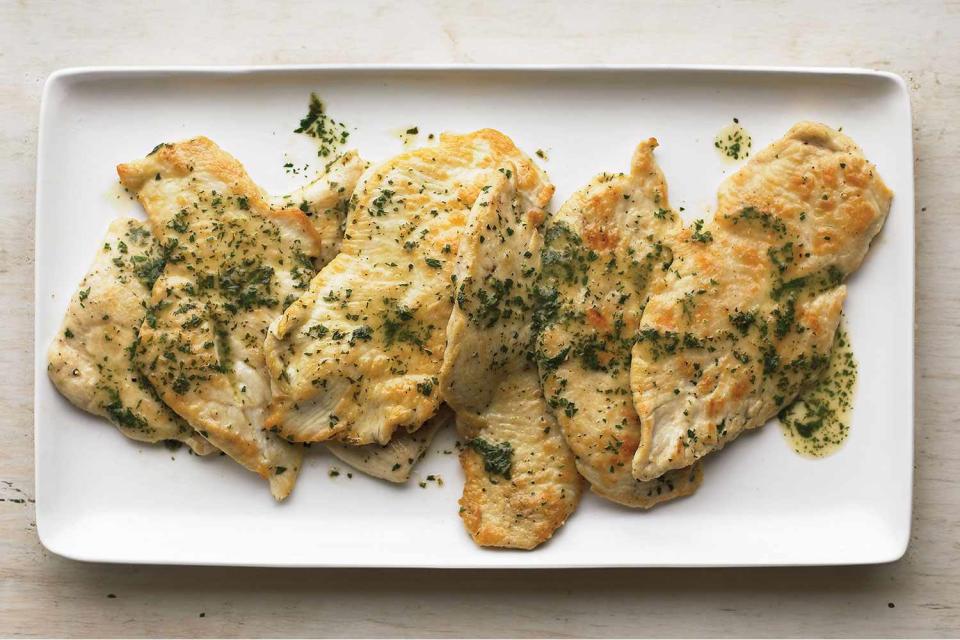How Chicken Tenderloin and Chicken Breast Are Different—and When to Use Each
These cuts may look similar, but they can't always be used interchangeably—we spoke to a chef who explains it all.

Martha Stewart
If you've spent some time in the poultry section of your supermarket, you've likely spotted packages of chicken tenderloins right next to chicken breasts. Though they're both white meat and quite lean, there are a few significant differences between the two. Knowing when to purchase one over the other will ensure you're making the appropriate choice for whatever you're cooking. To help learn more about the differences, we spoke to a chef who explains how the two cuts of chicken measure up in terms of taste, texture, size, and uses.
Meet Our Expert
Fred Maurer, executive chef at Arlo NoMad Hotel and NoMad Diner in New York City
Related: 3 Easy Ways to Turn Boneless, Skinless Chicken Breasts Into a Weeknight Dinner
What Is Chicken Breast?
Chicken breast is a lean, white muscle that lends itself to a wide range of cooking methods. While it can be sold with the bone and skin still intact, it is most commonly purchased boneless and skinless.
Where It's Located: Also known as the pectoralis major, the breast is located on the underside of a chicken. Each chicken has one whole breast, which is often split into two individual pieces.
Texture and Flavor: Chicken breast is mild in flavor, low in fat, and can remain juicy and tender as long as it's not overcooked. (For these reasons, it's an extremely desirable cut that fetches a higher price point than most other parts of the bird.)
Best Cooking Methods: Boneless, skinless chicken breasts can be easily sliced or chopped for stir-fries, pastas, or soups. Pounded thin, they can be turned into a paillard or fried up as schnitzel. Kept whole and either seared, roasted, or grilled, they're perfect for slicing onto sandwiches, shredding into stews or salads, or served as is.
Related: How to Butterfly a Chicken Breast in 3 Simple Steps
What Is Chicken Tenderloin?
Chicken tenderloin is a thin strip of white muscle that's sometimes labeled as "chicken tenders" in stores. "The term tenderloin is a bit of a misnomer," says Fred Maurer, executive chef at Arlo NoMad Hotel and NoMad Diner in New York City, "with its name likely stemming from its similarity in shape and tenderness to a tenderloin of pork or beef. But, in those animals, the tenderloin runs perpendicular to the rear portion of the loin and is separated by the spine."
Where It's Located: The chicken tenderloin is attached to the breast by a thin white tendon and lies beneath it, against the rib bones.
Texture and Flavor: The flavor of chicken tenderloin is very similar to that of the breast meat. You could argue that the tenderloin is slightly more tender, but you'd want to remove the tendon first to achieve maximum tenderness, says Maurer.
Best Cooking Methods: Tenderloins are extremely quick cooking and are best suited to breading and frying, baking, searing, or grilling.
The Differences Between Chicken Breast and Chicken Tenderloin
While similar in texture and flavor, chicken breast and tenderloin differ in other ways. Chicken breasts are larger, thicker, and more plump, whereas the tenderloin is far more petite, thin and narrow, and a bit more delicate. Due to these differences in size and shape, chicken breast takes longer to cook through than tenderloin.
Also, because there are only two small tenderloins per whole chicken, they tend to cost a bit more than breasts at the store.
Availability wise, you're pretty much always guaranteed to find boneless, skinless chicken breasts in stock, but some stores may not sell tenderloins separately.
"For many recipes, particularly hot and fast cooking methods like frying or stir-frying, I might use these two muscles interchangeably," says Maurer. But, he says there are plenty of things that the breast is good for where the tenderloin might not work: "A whole breast is far better on the grill or to be used for schnitzel. Most braising should be left for bone-in chicken."
Related: 30 Easy Weeknight Chicken Recipes Your Family Will Love
When to Use Chicken Tenderloin vs. Chicken Breast?
If you're roasting, steaming, or grilling, you'll most likely want to stick with chicken breasts as they'll be less likely to dry out given their size and thickness.
When making chicken fingers or skewering strips of chicken to sear or grill, reaching for chicken tenderloins will cut down on prep since they're already the perfect size and shape.
Chicken breast and tenderloin can be used interchangeably for stir-fries, soups, and salads.
Tips
If you can't find chicken tenderloin at the grocery store, you can always slice chicken breasts into strips to use in their place.
A Few of Our Favorite Chicken Breast Recipes:
A Few of Our Favorite Chicken Tenderloin Recipes:
Read the original article on Martha Stewart.

